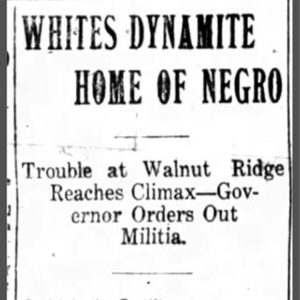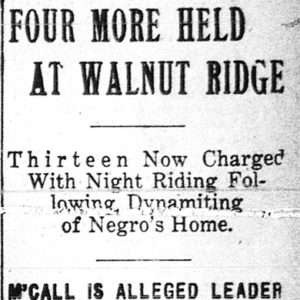calsfoundation@cals.org
Walnut Ridge Race War of 1912
The Walnut Ridge Race War of 1912 was an instance of violent nightriding (also known as whitecapping) in which a group of white vigilantes attempted to drive African Americans from the city of Walnut Ridge (Lawrence County). They did not succeed in making Walnut Ridge an all-white town, but they did manage to drive Black laborers from certain local industries, which was often the aim of nightriders, who were frequently poor whites who wanted those jobs for themselves.
In early April 1912, notices signed “Kit Karson and Band” were posted in Walnut Ridge ordering local African Americans to leave the city. A committee of white citizens responded to this threat by posting their own warnings to the band in question, asserting that “we will protect our help and prosecute you to the limit of the law. Furthermore, the white people will arm their servants with instructions to shoot the first intruders who disturb them.” The notice concluded, “When you go after the nigger, be sure you are not caught.” Despite this warning, on the night of April 19, a “crowd of unidentified white men” dynamited one Black-owned home (that of John Sanders), fired upon the house of another Black person, and “terrorized the entire [Black] section of the city for several hours,” ceasing only “when practically all of the negroes had fled from the district.”
Several “prominent citizens” of Walnut Ridge communicated with Governor George W. Donaghey that night, expressing “fears that bloodshed would result if immediate action was not taken.” In response, the governor called out the local militia, stationed at Black Rock (Lawrence County), to restore order. By the time the militia, under the command of Brigadier General William K. Surridge, arrived in the city, half of an estimated Black population of 400 was reported to have fled. Some white citizens reportedly opposed the militia quartering there, but state and local newspaper accounts generally credit the action with restoring peace in the city. However, no one was reportedly arrested or charged for the wave of terrorism.
This event bears similarities to other instances of nightriding in Lawrence County. On January 12, 1894, a group of unknown vigilantes posted a notice warning all African Americans to leave Black Rock. At the time, about 300 Black workers lived in the city, laboring in the timber and manufacturing industries. One third of them reportedly left in response to this threat, despite the fact that local industry leaders had pledged to protect them. (No violence erupted in that particular instance, though whitecappers did commit violence in the Black Rock area later in the 1890s.) In Walnut Ridge, vigilantes threatened specific employers. Black employees of the Phoenix Cotton Oil Company were driven from their workplace and ordered out of the county. Walnut Ridge and Black Rock were both communities that coalesced around railroad developments, and attendant timber industries, in the late nineteenth century. In these newly developed towns, African Americans were not well established and could be easily marginalized as new arrivals to a sparsely settled area.
In late April 1912, authorities arrested a total of thirteen men on charges of nightriding, naming Robert McCall as the leader of the gang. However, on May 1, 1912, the first of these alleged vigilantes, George Nance, was acquitted. Apparently, all of the other men arrested were soon released on the condition that they would “keep the peace and take the side of order” in the future.
While Walnut Ridge is generally not labeled a “sundown town,” African Americans constitute only about 1.8 percent of the population as of 2010, suggesting that the effect of this kind of exclusionary violence lingers to the present day.
For additional information:
“Alleged Night Rider Acquitted.” Arkansas Gazette, May 2, 1912, p. 2.
“Citizens Join to Protect Negroes.” Jonesboro Evening Sun, April 18, 1912, p. 1.
“Citizens Join to Protect Negroes.” Arkansas Gazette, April 19, 1912, p. 2.
“Four More Held at Walnut Ridge.” Arkansas Gazette, May 1, 1912, p. 1.
Jones, Catherine Ponder. “Terror at Night.” Lawrence County Historical Journal (2017, no. 2): 5–26.
“Militia in Camp at Walnut Ridge.” Arkansas Gazette, April 22, 1912, p. 2.
Perkins, J. Blake. “‘Kit Karson and Band’: Race, Class, and New South Nightriding in Northeast Arkansas.” Arkansas Historical Quarterly 81 (Autumn 2022): 252–281.
“Walnut Ridge Negroes Ordered to Leave by Whites, Militia Called.” Jonesboro Evening Sun, April 22, 1912, p. 1.
“Whites Dynamite Home of Negro.” Arkansas Gazette, April 21, 1912, pp. 1, 3.
Staff of the CALS Encyclopedia of Arkansas
 Civil Rights and Social Change
Civil Rights and Social Change Early Twentieth Century, 1901 through 1940
Early Twentieth Century, 1901 through 1940 Race Riots
Race Riots Cotton Oil Plant
Cotton Oil Plant  Walnut Ridge Race War Article
Walnut Ridge Race War Article  Walnut Ridge Race War Article
Walnut Ridge Race War Article 




I lived in Black Rock and went to school and graduated from there. I raised my kids there and they went to school there. I have never heard any of this information before. No wonder there aren’t more Black people in Lawrence County. The hatred was handed down from generation to generation. Lawrence County could have been a big industrial area more than it is if the racism was stopped years ago. I had the pleasure of knowing a Black lady named Beulah who lived in Black Rock when I was a kid. She helped a lot of people with her knowledge.